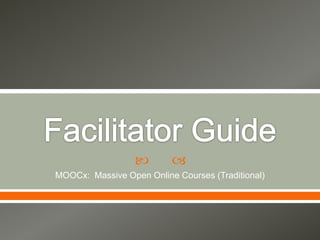Facilitator guide for moo cs 2 13-13
•Télécharger en tant que PPTX, PDF•
1 j'aime•1,113 vues
This is a simple facilitator guide for considerations for teaching a traditional MOOC (MOOCx.)
Signaler
Partager
Signaler
Partager

Recommandé
Recommandé
Contenu connexe
Similaire à Facilitator guide for moo cs 2 13-13
Similaire à Facilitator guide for moo cs 2 13-13 (20)
F208_PPT_Improving Teaching through Formative Observation Feedback - Final

F208_PPT_Improving Teaching through Formative Observation Feedback - Final
Global_Ed_TP_Trainer_Material1_Feedback-and-Error-Correction-Mar2019.ppt

Global_Ed_TP_Trainer_Material1_Feedback-and-Error-Correction-Mar2019.ppt
Early-stage educational steps needed to create more effective R&D drivers

Early-stage educational steps needed to create more effective R&D drivers
Plus de Pearson
Plus de Pearson (20)
Alignment Map Example and Template CC 12-17-14.docx

Alignment Map Example and Template CC 12-17-14.docx
Scaling Online Examples from State Institution Models

Scaling Online Examples from State Institution Models
Intentional Evolution: The Dynamic New Ecosystem of eLearn

Intentional Evolution: The Dynamic New Ecosystem of eLearn
Intentional Evolution: The Dynamic New Ecosystem of eLearn

Intentional Evolution: The Dynamic New Ecosystem of eLearn
Mission, vision and values statements in higher education

Mission, vision and values statements in higher education
ePortfolio Presentation for Guide to eLearning for Higher Education Administr...

ePortfolio Presentation for Guide to eLearning for Higher Education Administr...
Facilitator guide for moo cs 2 13-13
- 1. MOOCx: Massive Open Online Courses (Traditional)
- 2. Guiding the MOOC Managing Interactions with Students Continuous Improvement Division of Labor
- 3. Keeping Self-Paced Students On Track by Creating Community
- 4. Daily Announcements o Keep students updated, day-by-day o Keep announcements short – the explanations should be in the course itself o Provide encouragement o Redirect students to existing resources (see Managing Interactions with Students) Open Discussion Forums o Monitor daily o Jump in only when necessary o Reinforce your role often
- 5. Facilitating Sane Communication Streams
- 6. Set Expectations for Interaction o Tell students how, when, and why you will communicate with them o Reinforce your guidelines! o If a student contacts you the wrong way, respond to them to check out the interaction guidelines and resubmit their question in the right way. Remember, you’re teaching students how to treat you as a faculty leading a new type of learning experience. Nothing for One Purpose o Every interaction should be documented and shared in another way o If you answer an individual email, add that question to the FAQ o If there is confusion, solve an individual question in the Announcements
- 7. Communicate with Fellow Faculty o Help manage the workload collaboratively o Minimize Mommy/Daddy interactions o Start the process for continuous improvement
- 8. Figuring Out on the Fly What Works Better (Not Best)
- 9. Fix it In Flight o If something is causing problems, don’t wait till the next run of the course, see if you can fix it Track all changes o Keep a chart of requested and implemented updates o These can then be incorporated into the next course Reflect on the Why o Some things won’t be changed during the first or second run o Try to diagnose what is working and what isn’t and why o Find a
- 10. Decide Who Does What First
- 11. Decide Upfront Who Will… o Post daily announcements o Monitor discussion boards daily o Monitor email daily Decide Upfront How… o You will communicate changes, needs & info to fellow faculty o You will track FAQs for inclusion in the second course o You will communicate centrally with eLi
